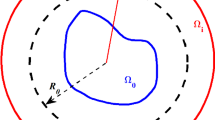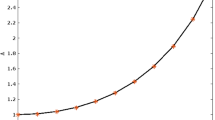Abstract
Modal analysis of the flux reconstruction (FR) formulation is performed to obtain the semi-discrete and fully-discrete dispersion relations, using which, the wave properties of physical as well as spurious modes are characterized. The effect of polynomial order, correction function and solution points on the dispersion, dissipation and relative energies of the modes are investigated. Using this framework, a new set of linearly stable high-order FR schemes is proposed that minimizes wave propagation errors for the range of resolvable wavenumbers. These schemes provide considerably reduced error for advection in comparison to the Discontinuous Galerkin scheme and benefit from having an explicit differential update. The corresponding resolving efficiencies compare favorably to those of standard high-order compact finite difference schemes. These theoretical expectations are verified by a comparison of proposed and existing FR schemes in advecting a scalar quantity on uniform as well as non-uniform grids.






















Similar content being viewed by others
References
Tam, C.K.W.: Computational aeroacoustics: issues and methods. AIAA J. 33(10), 1788–1796 (1995)
Visbal, M.R., Gaitonde, D.V.: Very high-order spatially implicit schemes for computational acoustics on curvilinear meshes. J. Comp. Acous. 09, 1259 (2001)
Wang, M., Freund, J.B., Lele, S.K.: Computational prediction of flow-generated sound. Annu. Rev. Fluid Mech. 38, 483512 (2006)
Moin, P., Mahesh, K.: Direct numerical simulation: a tool in turbulence research. Annu. Rev. Fluid Mech. 30, 53978 (1998)
Hesthaven, J. S., Warburton, T.: Nodal Discontinuous Galerkin Methods. Springer Texts in Applied Mathematics, 54, (2008)
Lele, S.K.: Compact finite difference schemes with spectral-like resolution. J. Comput. Phys. 103, 16–42 (1992)
Visbal, M.R., Gaitonde, D.V.: On the use of higher-order finite-difference schemes on curvilinear and deforming meshes. J. Comput. Phys. 181, 155–185 (2002)
Chavent, G., Cockburn, B.: The local projection \(P^0 P^1\)-discontinuous-Galerkin finite element method for scalar conservation laws. RAIRO Model. Math. Anal. Numer. 23, 565 (1989)
Lesaint, P., Raviart, P.A.: On a finite element method for solving the neutron transport equation. In: Mathematical Aspects of Finite Elements in Partial Differential Equations, p. 89. Academic Press, San Diego (1974)
Reed, W.H., Hill, T.R.: Triangular mesh methods for the neutron transport equation. Los Alamos Scientific Laboratory Report LA-UR-73-479 (1973)
Huynh, H.T.: A flux reconstruction approach to high-order schemes including discontinuous Galerkin methods. In: Huynh, H.T. (ed.) AIAA Conference Paper, 2007–4079 (2007)
Kopriva, D.A., Kolias, J.H.: A conservative staggered-grid Chebyshev multidomain method for compressible flows. J. Comput. Phys. 125, 244–261 (1996)
Liu, Y., Vinokur, M., Wang, Z.J.: Spectral difference method for unstructured grids I: basic formulation. J. Comput. Phys. 216, 780–801 (2006)
Vincent, P.E., Castonguay, P., Jameson, A.: A new class of high-order energy stable flux reconstruction schemes. J. Sci. Comput. 47(1), 50–72 (2011)
Jameson, A., Vincent, P.E., Castonguay, P.: On the non-linear stability of flux reconstruction schemes. J. Sci. Comput. 50(2), 434–445 (2012)
Castonguay, P., Vincent, P.E., Jameson, A.: A new class of high-order energy stable flux reconstruction schemes for triangular elements. J. Sci. Comput. 51(1), 224–256 (2012)
Huynh, H.T.: High-order methods including discontinuous Galerkin by reconstructions on triangular meshes. In: 49th AIAA Aerospace Sciences Meeting AIAA 2011-44
Williams, D.M., Jameson, A.: Energy stable flux reconstruction schemes for advection-diffusion problems on tetrahedra. J. Sci. Comput. (2013)
Castonguay, P., Williams, D.M., Vincent, P.E., Jameson, A.: Energy stable flux reconstruction schemes for advection-diffusion problems. Comput. Methods Appl. Mech. Eng. 267, 400–417 (2013)
Whitham, G.B.: Linear and Nonlinear Waves. Pure and Applied Mathematics, vol. 42. Wiley, New York (2011)
Tam, C.K.W.: Dispersion relation preserving finite difference schemes for computational aeroacoustics. J. Comput. Phys. 107, 262–281 (1993)
Adam, Y.: Highly accurate compact implicit methods and boundary conditions. J. Comput. Phys. 24, 10–22 (1977)
Haras, Z., Ta’asan, S.: Finite difference schemes for long-time integration. J. Comput. Phys. 114, 265–279 (1994)
Hirsch, R.S.: Higher order accurate difference solutions of fluid mechanics problems by a compact differencing technique. J. Comput. Phys. 19, 90–109 (1975)
Sengupta, T.K., Ganeriwal, G., De, S.: Analysis of central and upwind compact schemes. J. Comput. Phys. 192, 677–694 (2003)
Gottlieb, D., Orszag, S.A.: Numerical Analysis of Spectral Methods. SIAM, Philadelphia (1977)
Hu, F.Q., Hussaini, M.Y., Rasetarinera, P.: An analysis of the discontinuous Galerkin method for wave propagation problems. J. Comput. Phys. 151, 921946 (1999)
Hu, F.Q., Atkins, H.L.: Eigensolution analysis of the discontinuous Galerkin method with nonuniform grids. J. Comput. Phys. 182, 516–545 (2002)
Ainsworth, M.: Dispersive and dissipative behaviour of high order discontinuous Galerkin finite element methods. J. Comput. Phys. 198, 106–130 (2004)
Vincent, P.E., Castonguay, P., Jameson, A.: Insights from von Neumann analysis of high-order flux reconstruction schemes. J. Comput. Phys. 230, 81348154 (2011)
Van den Abeele, K.: Development of High-order Accurate Schemes for Unstructured Grids, Ph.D. thesis, Vrije Universiteit Brussel (2009)
Boyd, S., Vandenberghe, L.: Convex Optimization. Cambridge University Press, Cambridge (2004)
Powell, M.J.D.: A fast algorithm for nonlinearly constrained optimization calculations. In: Numerical Analysis, Lecture Notes in Mathematics, vol. 630, 144–157. Springer, Berlin (1978)
Optimization Toolbox User’s Guide—Version 5.0, (R2010a), The MathWorks Inc, Natick
Williams, D.M.: Energy stable high-order methods for simulating unsteady, viscous, compressible flows on unstructured grids. Thesis (Ph.D.)-Stanford University (2013)
Carpenter, M.H., Kennedy, C.: Fourth-order 2N-storage Runge–Kutta schemes, Technical Report TM 109112. NASA, NASA Langley Research Center (1994)
Kubatko E. J., Yeager B. A., Ketcheson, D. I.: Optimal strong-stability-preserving Runge-Kutta time discretizations for discontinuous galerkin methods. J. Sci. Comput. doi10.1007/s10915-013-9796-7
Acknowledgments
The authors are grateful to Prof. S. K. Lele (Professor, Department of Aeronautics and Astronautics, Stanford University) for motivating the problem and advising in the choice of relevant test cases, and to Francisco Palacios (Engineering Research Associate, Department of Aeronautics and Astronautics, Stanford University) for his suggestions regarding the manuscript. The first author would also like to thank David Williams (CFD Engineer, Flight Sciences division, Boeing Commercial Airplanes) and Manuel López (Ph.D. candidate, Department of Aeronautics and Astronautics, Stanford University) for valuable suggestions regarding the optimization problem. The first author was supported in this effort by the Thomas V. Jones Stanford Graduate Fellowship.
Author information
Authors and Affiliations
Corresponding author
Rights and permissions
About this article
Cite this article
Asthana, K., Jameson, A. High-Order Flux Reconstruction Schemes with Minimal Dispersion and Dissipation. J Sci Comput 62, 913–944 (2015). https://doi.org/10.1007/s10915-014-9882-5
Received:
Revised:
Accepted:
Published:
Issue Date:
DOI: https://doi.org/10.1007/s10915-014-9882-5




